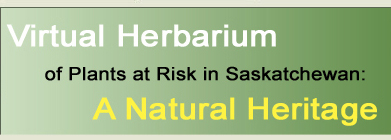|
| Erigeron hyssopifolius
Michx. |
|
| |
| TAXONOMY |
| |
| Family: |
Asteraceae or Compositae |
| Genus: |
Erigeron |
| |
| Species Synonyms: |
none |
| Common Names: |
hyssopleaf fleabane |
| |
| DISTRIBUTION |
| |
| Canada: |
Yukon Territory – Mackenzie District, Northwest
Territories – Keewatin District, Nunavut, to Newfoundland, south to
northeastern Alberta – central Saskatchewan – Ontario –
Nova Scotia |
| Saskatchewan: |
northern and central Saskatchewan |
| Ecoregion: |
Boreal Transition, Mid-Boreal Upland, Mid-Boreal
Lowland, Churchill River Upland, Athabasca Plain, Selwyn Lake Upland |
| |
| HABITAT |
| |
| Saskatchewan: |
wet soil in bogs, muskegs, and fens |
| Associated Species: |
Carex sp., Dasiphora fruticosa
ssp. floribunda, Larix laricina, Picea glauca, Picea mariana, Pinus
banksiana, Sphagnum sp., Triantha glutinosa ssp. glutinosa |
| |
| RARITY STATUS |
| |
Provincial
Status According
to Harms (2003): |
Threatened |
| Nature Conservancy
Status: |
G5 S2 |
Saskatchewan
Species at
Risk Status: |
None |
| COSEWIC Status:
|
None |
| |
| Erigeron hyssopifolius
occurs in two or three general regions in Saskatchewan. Populations
vary in size. No immediate threats are known or anticipated for this species. |
| |
| SPECIES
DESCRIPTION |
| |
| Height: |
15 – 35 cm tall |
| Roots: |
fibrous; rhizome branched |
| Stems: |
tufted from woody crown or solitary, slender,
1 – 1.5 mm thick, dark-coloured, glabrous or sparsely pubescent |
| Leaves: |
basal cluster absent, cauline, alternate, sessile,
leaves largest and crowded at the middle, leaves longer than internodes,
often with axillary shoots on higher leaves, 1 – 3 cm long, 2 –
3 mm wide, narrowly oblanceolate, apex acute to apiculate, glabrous or sparsely
pubescent, margin entire to ciliate |
| Inflorescence: |
heads 2 – many, < 1.5 cm in diameter;
peduncle slender, naked or with 1 – 2 bracts; phyllaries 4 –
6 mm high, thin, acuminate to attenuate, generally glabrous, occasionally
a few viscid hairs |
| Flowers: |
ligulate florets 20 – 50, 4 – 8 mm
long, 0.4 – 1.4 mm wide, purple or white; no rayless pistillate flowers
present between ligulate and tubular florets; tubular florets perfect, slender
corollas |
| Fruits: |
pappus single, capillary bristles |
| |
| ERIGERON
SPECIES FOUND IN SASKATCHEWAN |
| |
| 1 Leaves dissected |
E. compositus |
| 1 Leaves not dissected |
2 |
| |
|
2 Rays absent or inconspicuous (<
6 mm; if longer than 6 mm, < 1 mm wide)
|
3 |
| 2 Rays present (> 6 mm) |
9 |
| |
|
| 3 Involucre glabrous |
Conyza canadensis var. canadensis |
| 3 Involucre pubescent and/or glandular |
4 |
| |
|
| 4 Involucre glandular, may be sparsely
pubescent |
5 |
| 4 Involucre pubescent, but not glandular |
6 |
| |
|
| 5 Several to many heads; densely glandular
involucre |
E. acris ssp. politus |
| 5 Head solitary; somewhat glandular
involucre |
E. acris ssp. debilis |
| |
|
| 6 Pappus double |
7 |
| 6 Pappus single |
8 |
| |
|
| 7 Phyllary hairs flattened, stem hairs
appressed |
E. strigosus var. septentrionalis |
| 7 Phyllary hairs terete, stem hairs
appressed to ascending |
E. strigosus var. strigosis |
| |
|
| 8 Leaves shorter than peduncles of
flower heads; inflorescence corymbose, occasionally solitary; rayless pistillate
flowers present between ray and disc flowers |
E. elatus |
| 8 Leaves sometimes exceeding lower
heads in inflorescence; inflorescence racemose; occasionally solitary; rayless
pistillate flowers absent |
E. lonchophyllos |
| |
|
| 9 Plants < 20 cm high; heads few
to solitary |
10 |
| 9 Plants > 20 cm high; heads 2
– many |
12 |
| |
|
| 10 Leaves usually basal only; flowers
white |
E. radicatus |
| 10 Cauline leaves present; flowers
yellow or purple (if white, leaves 3 – 7 cm long) |
11 |
| |
|
| 11 Leaves 3 – 7 cm long, with
1 – 3 cauline leaves; flowers yellow to white or lavender |
E. ochroleucus var. scribneri |
| 11 Leaves 1 – 3 cm long, many
cauline leaves; flowers purple |
E. hyssopifolius |
| |
|
| 12 Stems scapose or subscapose |
E. pumilus |
| 12 Stems distinctly leafy, often reduced
upwards |
13 |
| |
|
| 13 Ray florets coloured |
14 |
| 13 Ray flowers white |
16 |
| |
|
| 14 Stem leaves largest at the middle
of stem |
E. hyssopifolius |
| 14 Stem leaves reduced upwards |
15 |
| |
|
| 15 Leaves clasping and auriculate |
E. philadelphicus var. philadelphicus |
| 15 Leaves not clasping or auriculate |
E. glabellus var. glabellus |
| |
|
| 16 Stem leaves largest at the middle
of stem |
E. hyssopifolius |
| 16 Stem leaves reduced upwards |
17 |
| |
|
| 17 Perennial with woody caudex, tough
rhizome, or thick taproot |
18 |
| 17 With neither deep-well developed
rhizomes nor woody caudices, at most a short rhizome or stolons |
19 |
| |
|
| 18 Caudex; stem leaves 5 – 7 |
E. glabellus var. glabellus |
| 18 Thick taproot; stem leaves >
10 |
E. caespitosus |
| |
|
| 19 Pappus of ray and disc florets
unlike (pappus of rays single) |
E. annuus |
| 19 Pappus of ray and disc florets
alike |
E. asper |
|






